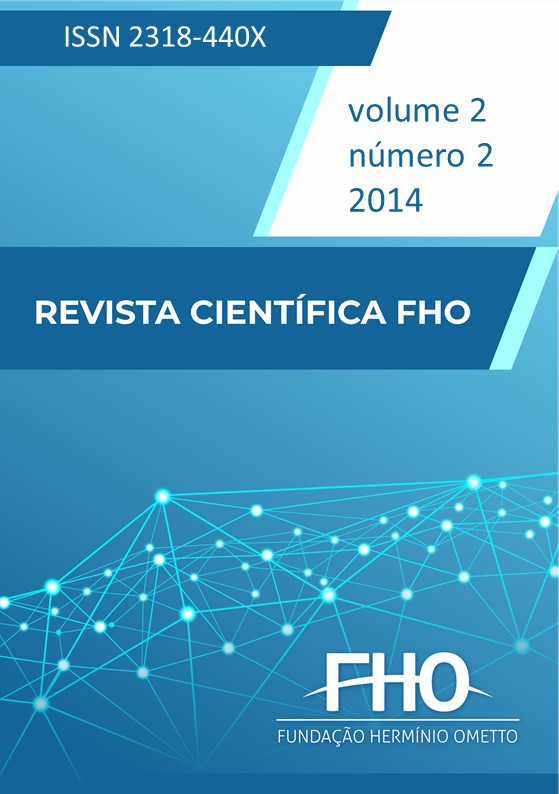Abstract
The minimally processed vegetables consumption has become quite popular nowadays, because they are already cleaned and packaged. Processing steps such as utting and chipping usually increase the population of microorganisms, consequently reducing food shelf life. Even though potentially pathogenic microorganisms are absent, a large number of microorganisms can indicate that food is unhealthy. To evaluate the sanitary quality of these foods, the Brazilian legislation establishes limits on the count of thermotolerant coliforms and Salmonella sp. The objective of this study was to evaluate the microbiological quality of 20 samples of minimally processed vegetables sold in the city of Araras (SP) according to microbiological standard established by resolution n. 12 of January 2, 2001 - ANVISA. The method was followed according to the techniques described by Silva; Junqueira e Silveira (2001). It was found that 35% of the samples had fecal coliform counts above the established by law. High counts of total coliforms were also found in the products (55%), indicating inadequate hygienic conditions during processing, storage and compromising their microbiological quality. In the present study was not detected the presence of Salmonella in any sample. It follows that it is necessary a greater quality control in these foods, from harvesting of the raw material to its consumption, especially during stages of cutting and slicing, making it necessary to adopt an effective system of control in order to ensure healthy and safe product for the consumer.
References
ALVES, J. A. et al. Qualidade de produto minimamente processado à base de abóbora, cenoura, chuchu e mandioquinha-salsa. Ciência e Tecnologia de Alimentos, Campinas, v. 30, n. 3, p. 625-634, 2010.
ARTÉS, F.; GÓMEZ, P. A.; ARTÉSHERNÁNDEZ, F. Physical, physiological and microbial deterioration of minimally fresh processed fruits and vegetables. Food Science and Technology International, Cartagena, v. 13, n. 3, p. 177-188, 2007.
BERBARI, S. A. G.; PASCHOALINO, J. E.; SILVEIRA, N. F. A. Efeito do cloro na água de lavagem para desinfecção de alface minimamente processada. Ciência e Tecnologia de Alimentos, Campinas, v. 21, n. 2, p. 197-201, 2001.
BEUCHAT, L. R. Ecological factors influencing survival and growth of human pathogens on row fruits and vegetables. Microbes and Infection, Georgia, v. 4, n. 4, p. 413-423, 2002.
BRASIL. Ministério da Saúde. Secretaria de Vigilância Sanitária (SVS). Portaria n. 326 de 30 de julho de 1997. Diário Oficial da União, Brasília, DF, 1o ago. 1997.
BRASIL. Ministério da Saúde. Agência Nacional de Vigilância Sanitária - ANVISA. Resolução RDC 12 de 2 de janeiro de 2001. Diário Oficial da União, Brasília, DF, 10 jan. 2001.
BRASIL. Ministério da Saúde. Agência Nacional de Vigilância Sanitária - ANVISA. Resolução RDC n. 275 de 21 de outubro de 2002. Diário Oficial da União, Brasília, DF, 6 nov. 2002.
CABRINI, K. T. et al. Pesquisa de coliformes totais e Escherichia coli em alfaces (Lactuca sativa) comercializadas na cidade de Limeira, São Paulo. Higiene Alimentar, Limeira, v. 16, n. 95, p. 92-94, 2002.
CHINNICI, G.; D’AMICO, M.; PECORINO, B. A multivariate statistical analysis on the consumers of organic products. British Food Journal, Catania, v. 104, Iss. 3/4/5, p. 187-199, 2002.
CRUZ, A. G.; CENCI, S. A.; MAIA, M. C. A. Pré-requisitos para implementação do sistema APPCC em uma linha de alface minimamente processada. Ciência e Tecnologia de Alimentos, Campinas, v. 26, n. 1, p. 104-109, 2006.
SVS – Secretaria de Vigilância em Saúde. Epidemiologia e Serviços de Saúde. Brasília: Ministério da Saúde, 1992.
GOPAL, A. et al. Application of non-conventional disinfection techniques to extend the shelf-life of minimally processed foods. In: World Congress of Food Science and Technology, 10., Sydney. Anais… Sydney: Abstract Book, 1999.
NGUYEN-THE, C.; CARLIN, F. The microbiology of minimally processed fresh fruits and vegetables. Critical Reviews in Food Science and Nutrition, v. 34, n. 4, p. 371-401, 1994.
OETTERER, M.; REGITANO-D’ARCE, M. A. B.; SPOTO, M. H. F. Fundamentos de ciência e tecnologia de alimentos. São Paulo: Manole, 2006.
OLIVEIRA, A. M. C. Estudo das características físico-químicas e microbiológicas de abacaxi (Ananascomosus), goiaba (Psidiumguajava L.) e maracujá (P. edulis L.) minimamente processados. 2005. Dissertação (Mestrado em Tecnologia de Alimentos) – Departamento de Tecnologia de Alimentos, Universidade Federal do Ceará, Fortaleza, 2005.
PACHECO, M. et al. Condições higiênico‐sanitárias de verduras e legumes comercializados no CEAGESP de Sorocaba ‐ SP. Higiene Alimentar, Sorocaba, v. 16, n. 101, p. 50-55, 2002.
SILVA, N. da; JUNQUEIRA, V. C. A.; SILVEIRA, N. F. A. Manual de métodos de análise microbiológica de alimentos. 2. ed. São Paulo: Livraria Varela, 2001.
ZANCO, M. Avaliação Higiênico-sanitária de frutas, hortaliças e vegetais minimamente processadas. 2005. Trabalho de Conclusão de Curso – Centro Universitário Hermínio Ometto, 2005.

This work is licensed under a Creative Commons Attribution-NonCommercial 4.0 International License.
Copyright (c) 2014 Renan Bazuco Frittoli; Luiz Henrique Rodrigues
